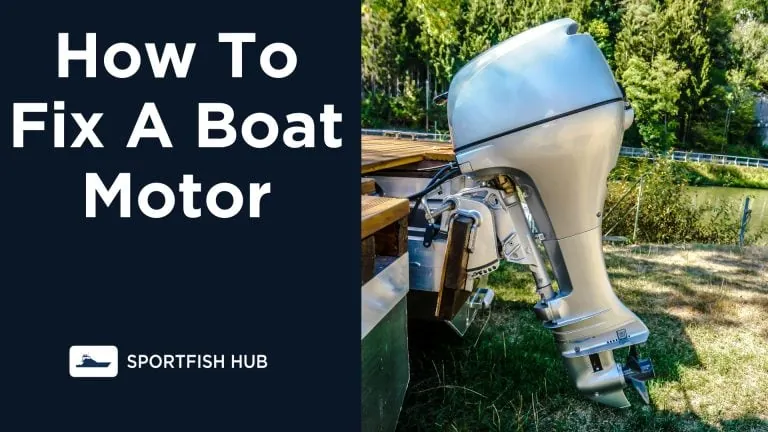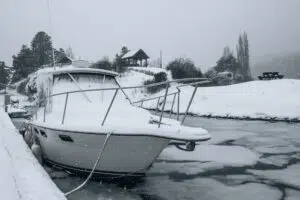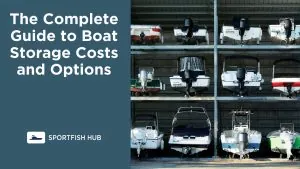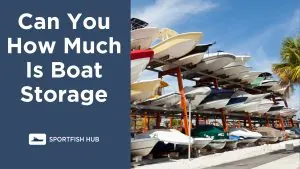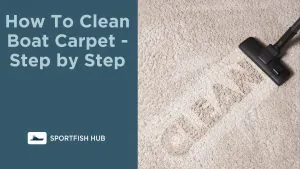Getting stuck on the water because of engine problems is every boater’s nightmare, so knowing the basics of how to fix a boat motor can keep your outings running smoothly.
This article will walk through the steps for diagnosing and repairing some of the most common motor issues using just a few tools and some mechanical know-how.
Table of Contents
- 1. Engine Won’t Start
- 2. Engine Is Overheating
- 3. Loss of Power
- 4. Engine Vibration/Shaking
- 5. Electrical Problems
- 6. Starter Motor Failure
- 7. Engine Leaks Oil
- 8. Engine Runs Rough
- 9. Engine Surges/Sputters
- 10. High Engine Temperature
- Summary of Troubleshooting Tips
- Conclusion
- FAQ
- How can I tell if my boat engine needs a tune-up?
- How often should I change my boat’s impeller?
- My boat is spewing water from the exhaust – what does this mean?
- Why does my outboard motor lose power at high RPMs?
- Can I use automotive oil in my boat motor?
1. Engine Won’t Start
The most obvious sign of trouble is when the engine simply won’t start. There are several potential causes for this:
- Dead battery – Check battery connections and charge if needed. Try jump-starting the engine from another battery source.
- Tripped circuit breaker or blown fuse – Reset breakers and replace any blown fuses.
- Fuel supply issues – Make sure the fuel tank has gas and check for blockages or leaks in fuel lines.
- Faulty ignition system – Test plugs, wires, distributor cap and rotor.
- Engine flooding – Wait a few minutes and try starting again. If flooded, you may need to remove and dry plugs.
- Starter motor failure – Tap starter with wrench/hammer to try freeing stuck motor.
Diagnosing Tips
- Check battery and electrical connections first
- Verify fuel supply and quality of gasoline
- Inspect plugs and ignition system parts
- Consider starter motor failure last after other causes ruled out
2. Engine Is Overheating
An overheating engine is another common problem that can have multiple contributing factors:
- Low coolant/antifreeze or leaks – Top off or repair leaks and bleed air from system.
- Faulty thermostat – Replace the thermostat if not opening properly.
- Damaged impeller – Replace any time you see it’s worn or damaged.
- Debris obstructing cooling system – Clean intake, lines, filter to improve water flow.
- Failing water pump – Test pump output and rebuild or replace if needed.
- Engine load too high – Reduce throttle/engine RPM if overworking the motor.
Remedying Tips
- Check coolant level, leaks, flow first
- Inspect the impeller and clear obstructions
- Consider thermostat or water pump failure
- Monitor engine temperature and loads
3. Loss of Power
A sudden loss of engine power can leave you stranded. Look at these potential sources:
- Fuel starvation – Low fuel or blockage in your filters/injectors.
- Fouled spark plugs – Inspect and clean/replace all your plugs.
- Engine timing issues – Verify cam, crankshaft timing with manual.
- Prop problems – Remove and check the prop for damage. Replace if needed.
- Engine Too Hot – Check cooling system components (see issue #2).
- Low engine compression – Test compression on all cylinders. May indicate worn piston rings or valve issues.
Diagnosing Tips
- Check fuel delivery and plugs first
- Inspect the prop and cooling system
- Consider internal mechanical problems last
4. Engine Vibration/Shaking
New vibrations or shaking can indicate propeller or drivetrain issues:
- Damaged prop – Inspect your prop(s) for damage like bent/cracked blades or hub.
- Debris tangled in prop – Remove weeds, fishing line, or other debris fouling prop.
- Lower unit/outdrive problem – Check for damaged gears or oil leaks requiring repair.
- Engine mount issue – Tighten loose mount fasteners or replace broken rubber mounts.
- Bent driveshaft – Requires removal and inspection of driveshaft.
Tips To Troubleshoot
- Start with visible external components like your prop
- Check the lower unit/outdrive next
- Consider internal drivetrain issues last
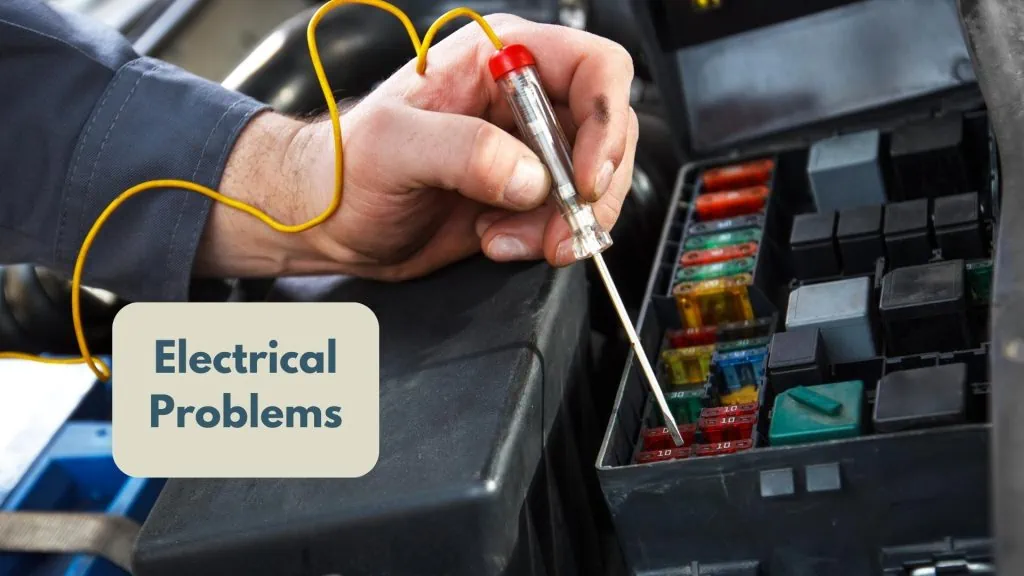
5. Electrical Problems
Electrical issues can cause a variety of engine problems. Some areas to investigate:
- Loose or dirty connections – Clean and tighten battery terminals and engine wiring connections.
- Charging system failure – Test alternator output. Check belts and connections.
- Short circuits – Isolate short circuits using multimeter or test lights. Inspect wiring insulation.
- Corroded wires – Clean corrosion from terminals and wire ends. Replace damaged wires.
- Blown fuses – Find and replace any blown fuses with proper new fuse.
Diagnostic advice
- Clean, tighten electrical connections first
- Test alternator output and charging voltage
- Isolate short circuits using multimeter
6. Starter Motor Failure
Problems with the starter motor can prevent the engine from cranking:
- Dead battery – Charge battery and test voltage output.
- Loose connections – Check wiring to starter solenoid and motor. Clean and tighten.
- Bad starter solenoid – Bypass solenoid temporarily using screwdriver to test. Replace if needed.
- Bent armature – Remove and inspect starter motor. Replace if damaged internally.
- Stuck brushes or bushings – Clean brushes and check brush springs. Lubricate bushings.
Problem diagnosis techniques
- Check battery and connections first
- Bypass solenoid to isolate issue
- Remove and inspect starter motor
- Clean brushes and bushings
7. Engine Leaks Oil
Oil leaks create mess and contaminate the water. Identify the source:
- Loose drain plug – Tighten drain/fill plugs in lower unit/sump. Use new gasket if needed.
- Lower unit seal failure – Replace leaky seals on propeller shaft.
- Damaged oil lines/hoses – Inspect hoses and tighten fittings. Replace damaged hoses.
- Failed gaskets/seals – Retorque head bolts. Replace worn head gaskets and seals.
- Cracked engine block – Isolate crack location. May require engine overhaul or replacement.
Tips For Repair
- Check exterior sources like drain and prop seals first
- Look for damaged hoses and leaky gaskets
- Cracked blocks require engine removal
8. Engine Runs Rough
Running poorly can have many causes:
- Dirty fuel filters – Replace clogged or old filters.
- Contaminated fuel – Drain tanks and refill with fresh gasoline. Add fuel stabilizer.
- Fouled plugs – Remove and inspect plugs. Clean or replace as needed.
- Fuel pump failure – Test pump pressure and volume output. Replace if needed.
- Plugged fuel injectors – Remove and clean injectors if they’re dirty.
- Engine timing issue – Check and set ignition timing according to manual.
Troubleshooting Tips
- Start with easy items like fuel and filters
- Inspect spark plugs
- Check fuel pump and injectors
- Consider timing issues last
9. Engine Surges/Sputters
Erratic running with surging and sputtering typically indicates a fuel delivery problem:
- Water in the fuel – Drain and clean the tank. Replace with fresh gasoline.
- Clogged fuel filters – Change fuel filters.
- Faulty fuel pump – Test pump output pressure. Rebuild or replace.
- Plugged fuel injectors – Remove and clean injector nozzles if contaminated.
- Vapor lock – Tighten fuel line fittings. Consider fuel line insulation upgrades.
Troubleshooting Tips
- Start with fuel – drain/replace, change filters
- Inspect fuel pump and injectors
- Consider effects of heat like vapor lock
10. High Engine Temperature
If the engine is running too hot, check these common problem areas:
- Low engine oil level – Add oil to reach proper level on dipstick.
- Failed thermostat – Replace thermostat if not opening properly.
- Low coolant level – Check for leaks. Refill coolant/antifreeze to reach proper level.
- Damaged impeller – As stated in above, always replace if worn or damaged in any way.
- Debris clogged in cooling system – Clean intake, hoses, filter to improve water flow.
Troubleshooting Tips
- Check oil and coolant levels first
- Inspect thermostat and impeller
- Clear obstructions in cooling system
Summary of Troubleshooting Tips
- Verify basics like fuel, oil, electrical and starter before digging deeper
- Focus on visible externals like propellers before internal engine repair
- Consider causes from simplest to more complex
- Use engine manual for detailed troubleshooting tips
- Maintain your engine to prevent issues before they happen
Conclusion
Knowing the most common problems and outboard engine experiences along with likely causes and solutions can help you quickly troubleshoot issues and get back on the water. Of course, significant mechanical repairs may require the expertise of a professional marine mechanic. But being able to diagnose basic problems yourself is an important skill for any boat owner.
FAQ
-
How can I tell if my boat engine needs a tune-up?
Signs like hard starting, rough idling, lack of power, or increased fuel consumption indicate your engine may need a tune-up with spark plug, fuel filter, and ignition system checks.
-
How often should I change my boat’s impeller?
Impellers usually need replacing every 2-3 years or 200 hours to prevent overheating failures. Check condition annually.
-
My boat is spewing water from the exhaust – what does this mean?
Water coming from the exhaust indicates a possible problem with the water pump impeller, failed engine seals, or a crack in the engine block.
-
Why does my outboard motor lose power at high RPMs?
Some common reasons are incorrect propeller pitch/sizing, damaged prop causing cavitation, or inadequate fuel delivery from clogs or pump failure.
-
Can I use automotive oil in my boat motor?
No, you should only use oil designed specifically for marine engines. Auto oil lacks additives for water cooling systems.

